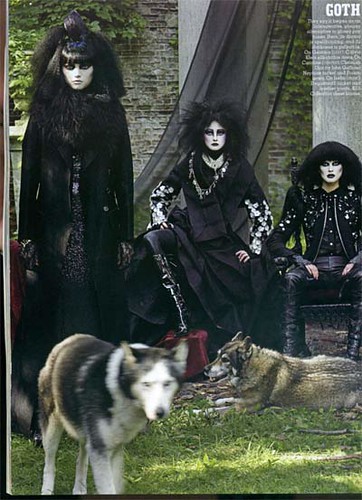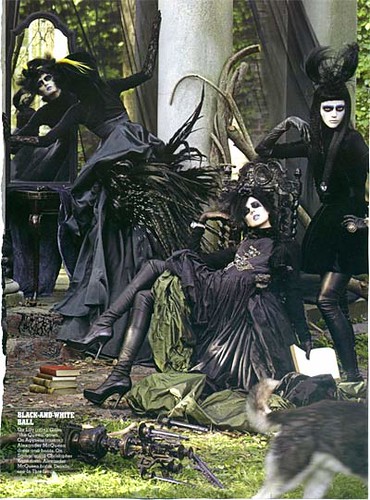
W Magazine Goth Spread, originally uploaded by Coilhouse.
Originally posted by my friend Kat – see her entry for larger pics of the above.
Posted by Nadya Lev on August 30th, 2007
Filed under Fashion, Goth, Photography | Comments (7)
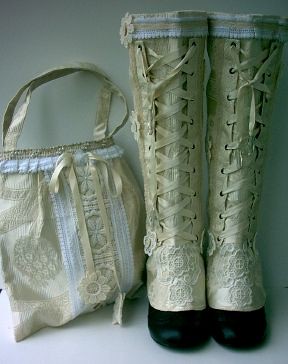
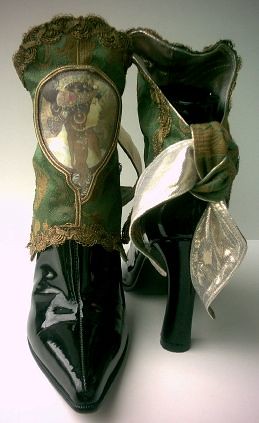
Maide’s Luxury Spats, originally uploaded by Coilhouse.
Bayern, Germany-based designer Maide has been creating her unique spats and gaiters for nearly a decade. “Nostalgia is one main theme of my work which I can not deny, obviously.” Inspired by Victorian and Edwardian textiles as well as the paintings of Mucha, Klimt, and Carl Larsson, her accessories integrate exquisite samples of early 20th century lace, trim, and appliqué. Each design is a meticulously handcrafted piece of wearable art. Brava, Maide!
Posted by Meredith Yayanos on August 29th, 2007
Filed under Art, Fashion, Ye Olde | Comments Off on Maide’s luxury spats & gaiters

From late 1896 through early 1897, a full ten years before the flight of the first known powered dirigible, thousands of people across America claimed to see strange lights in the night sky, heard voices and music emanating from a mysterious airship. Some accounts described a cigar-shaped gasbag, others noted vast flapping canvas wings and large wheels like a paddle steamer’s. One early eye witness even insisted he’d glimpsed two men suspended in the ship’s undercarriage, furiously working bicycle pedals. From Sacramento to Chicago, folks from all walks of life strove to convince skeptical journalists that what they’d seen was not, in fact, an elaborate hoax.
The most carefully researched book written to date about the phenomenon is probably The Great Airship Mystery by Daniel Cohen. Cohen gives a well-rounded account of the circumstances and evidence before concluding –quite sensibly– that the airship probably never existed. (Bummer.)
Several other authors have offered up far more juicy theories. Michael Busby maintains in his own book Solving the 1879 Airship Mystery that a secret society of mad genius inventors joined forces to build a handful of highly advanced aircraft worthy of Jules Verne, each of which, after being viewed by countless drunken farmhands in the Midwest, inexplicably crashed and burned over the Atlantic ocean.
Noted ufologist/parapsychologist/journalist John Keel includes the sightings in the book UFOs: Operation Trojan Horse as compelling evidence for his long-standing hypothesis that certain “non-human or spiritual intelligence sources” have been staging elaborate events for centuries to manipulate and misinform the human pysche. (Other examples he cites include the fairy folklore of Middle Europe, vampire legends, black helicopter sightings, poltergeist phenomena and UFOs.)
Although the initial sightings in the US ended in 1897, several more sightings occurred in England, Europe and New Zealand from 1909 through 1913. In 1912, vaudeville superstars Elsie Baker and Billy Murray penned a little ditty about the airship fervor entitled “Mysterious Moon” and recorded it on wax cylinder.
A comprehensive list of newspaper clippings from 1897 newspapers can be found here. Wikipedia’s got a good entry on the subject as well.
Posted by Meredith Yayanos on August 28th, 2007
Filed under Books, Conspiracy theories, Crackpot Visionary, Cryptohistory, Culture, Music, Sci-fi, Surreal, Ye Olde | Comments (9)

Mammoth Crocs, originally uploaded by sabor.tijuana.
Sloppy and sweaty! mmfft.
The herds of peroxide-silicone-fried chicken-flesh types [velour leisure suits proudly stuffed into UGGs or flopping around lost duckling-style in micro-shorts and Crocs] now have another option for comfort and Hawt Glamour Fashion! Rejoice. Rejoice while you can…
Posted by Zoetica Ebb on August 28th, 2007
Filed under Fashion, Silly-looking types, We disapprove, Why | Comments (7)
Design your own playground
Children sold separately. See your dealer for details.
Posted by Mildred Von on August 26th, 2007
Filed under Art, End of the World, Technology, War | Comments Off on Girls need not apply
Latest news stories reveal that the the Thor Equities plan to destroy Coney Island as we know it is dead in the water. And what a shame!
Listen, I know that Coney Island is a magical pocket of time and space that feels like walking inside an endless antique funhouse mirror. I know the chill of entering The Ghost Hole. I know that no score in life is sweeter than getting Mad Max right in the face in a game of Shoot the Freak. And I’ll dislocate my neck again any day for a ride on the world’s oldest wooden roller coaster.
Knowing all this, how can I support the re-construction of Coney Island? Two words: “dystopian pleasuredome.” Some of the concept designs for the new Coney Island are so nasty, garish, lurid and kitsch, that it just might work. I hope they do it. In fact, I hope that the designs get even worse, for that will take it to a whole new level. Just look at this:

It looks like somebody took Second Life and extrapolated it into the real world – all you need are some flying penises and the picture is complete. I’m convinced that this is what Coney Island needs to become truly great again. At some point, the proposed concept drawings promised us a Coney Island filled with dozens of translucent mini parachute jumps, skyscraper-tall holographic projections, roller coasters that wind from building to building like curly monorails, a rooftop landing pad for blimps, and something called “The Freakenspiel” – a “merry-go-round and water fountain topped by a pyrotechnic elephant.” However, the latest renderings, in response to worldwide pressure to “Save Coney Island,” have been markedly more traditional and therefore boring. Nobody wants to see the same old carnival facades, devoid of the layer of unwashable grime and stories that made Coney Island so compelling. So blast it all to hell and bring on the Jellyfish on Sticks.
Posted by Nadya Lev on August 21st, 2007
Filed under Cirque, End of the World | Comments (5)
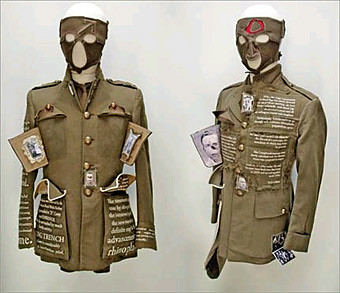
Paddy Hartley Project Facade, originally uploaded by Coilhouse.
Project Facade tells “the personal and surgical stories” of servicemen who sustained deforming injuries during World War One. The site displays the uniform sculptures as components of thoroughly-researched case studies that include the name, face and injury catalogue of each soldier, presenting a sculpture that’s unique for each man’s story. The most detailed case studies belong to Sea. AJ, Fai. W, and Top. V, though all are worth examining. Warning: there are images of facial deformities here that are not for the weak of heart!
Some uniforms are fragmented with blood-red stitching reminiscent of shrapnel wounds, others are inscribed with writing that conjures medical records or letters from loved ones, and many uniforms are complemented by stiff masks that project power and authority while hiding a the personal horror of a face literally erased by war. The project is two-fold: in addition to examining the history of facial/body reconstruction with the aforementioned uniform sculptures, Hartley also investigates modern techniques by creating Bioactive Glass Facial Implant sculptures, comparing today’s technology to the surgical techniques that Sir Harold Gillies pioneered in the early 1900s. The result is a powerful artistic response to the history of facial reconstruction, as experienced both by the patient and as the surgeon.
Posted by Nadya Lev on August 20th, 2007
Filed under Art, Medical, Uniform, War | Comments (2)
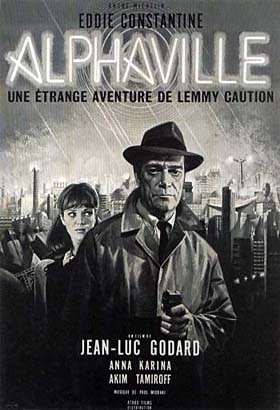
Alphaville, originally uploaded by Coilhouse.
Darkly satirical, set in an Orwellian alter-reality Paris and filled with collages of stark dystopian imagery throughout, it had me hooked at totalitarian robot-controlled city.
Filmed on Godard’s conservative budget, Alphaville makes its financial limitations known with bypassing flashy special effects in favor of brazen heavy-handed symbolism i have no choice but to adore.
Political oppression, brooding super-detective, eerie villains, style, an awkwardly disjointed romance and nods to a variety of classics – impossible to resist!
Sometimes reality is too complex for oral communication. But legend embodies it in a form which enables it to spread all over the world.
Posted by Zoetica Ebb on August 18th, 2007
Filed under Film, Vive la France | Comments (1)
“We order that the poets’ rights be revered:
- To enlarge the scope of the poet’s vocabulary with arbitrary and derivative words (Word-novelty).
- To feel an insurmountable hatred for the language existing before their time.
- To push with horror off their proud brow the Wreath of cheap fame that You have made from bathhouse switches.
- To stand on the rock of the word “we” amidst the sea of boos and outrage.
And if for the time being the filthy stigmas of your “common sense” and “good taste” are still present in our lines, troche these same lines for the first time already glimmer with the Summer Lightning of the New Coming Beauty of the Self-sufficient (self-centered) Word.”
— 1917 David Burliuk, salve Alexander Kruchenykh, Vladimir Mayakovsky and Victor Khlebnikov. From A Slap in the Face of Public Taste, one of the few non-Italian authored Futurist manifestos.
Posted by Zoetica Ebb on August 9th, 2007
Filed under Culture | Comments Off on Slap in the Face of Public Taste


